- Processes operating on the exterior of the earth resulting in the formation of natural physical features. These are:
- weathering
- mass wasting
- erosion
- transportation
- deposition
Weathering
- Mechanical breakdown or chemical decay of rocks “in situ” (without movement)
Agents of weathering -Things that work to cause it:
- Weather elements:
- rainfall
- temperature
- frost
- gases e.g. CO2,O2
- Plants
- Animals
- People
Factors That Influence Weathering
Climate
- Different areas with different climatic elements experience different types of weathering e.g. block disintegration are experienced in arid areas while frost action is experienced in temperate regions and mountainous regions of tropics.
Topography
- Weathering is faster on steep slopes than on gentle slopes because weathered material is washed away quickly exposing the rock once again to agents while on gentle slopes materials remain in one position shielding the rock from weathering agents.
Nature of rocks
- Dark coloured rocks absorb more heat than light coloured ones hence break faster due to excessive expansion and contraction.
- A rock with different minerals may disintegrate faster due to differential expansion and contraction of minerals.
- A well jointed rock will break faster because physical and chemical agents can penetrate faster e.g. by freezing and thawing.
- Fine textured rocks have a large surface area on which chemical processes can act e.g. Limestone.
Biological organisms
- Bacteria facilitate rotting of organic matter producing organic acids which reacts with some minerals causing the rock to break up.
- Plant roots and burrowing animals penetrate rocks resulting in cracks providing passage for agents such as water to act on rocks.
- People accelerate the rate of weathering by exposing rocks buried deep below by digging, blasting and drilling.
Types of Weathering
- Mechanical Weathering – Physical break up of rocks without change in their chemical composition.
Processes
Block Disintegration/Separation
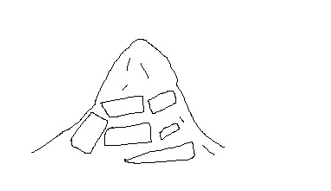
- Breaking of rocks into blocks along the joints.
- It‟s effective in arid areas because of great diurnal temperature range.
- Day, well jointed rocks are subjected to intense heating causing minerals in it to expand. o In the night the rock is cooled causing it to contract.
- The rock joints enlarge due to the alternating cooling and contraction.
- The process is repeated over a long time causing the rock to disintegrate into blocks along the joints e.g. Mundanda rock in Tsavo East.
Exfoliation
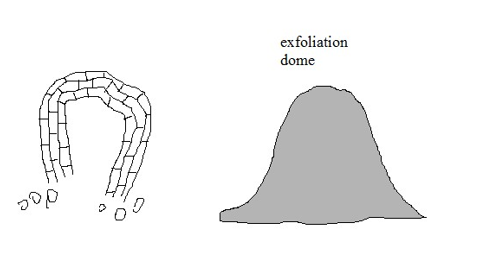
- Peeling off of layers of rocks.
- Also common in arid areas.
- Day, rock surface is heated more than inner layers because rocks are poor conductors of heat. o The surface expands more than inner layers causing strain between the two layers.
- With time outer layer develops cracks and later peels off and pieces of rocks fall down under gravity e.g. along Mombassa-Nairobi road between Mtito Andei and Voi.
Granular Disintegration
Disintegration of rocks into grains.
- Occurs in rocks with different minerals.
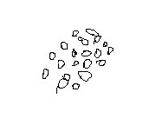
- When the rock is heated, different minerals expand differently.
- Internal stress results and with time the rock disintegrates into grains.
Pressure Release/Sheeting/Unloading –
Disintegration of rocks due to expansion when weight is removed from over it.
- Soil and other materials lying on top of a rock are removed by erosion and mass wasting (denudation). o The exposed rock expands when the weight that was pressing it is removed. o The outer layer curves and eventually shells are pulled out from the rock.
- The result is formation of a high rocky hills called granitic tors e.g. Maragoli and parts of Machakos.
Frost Action
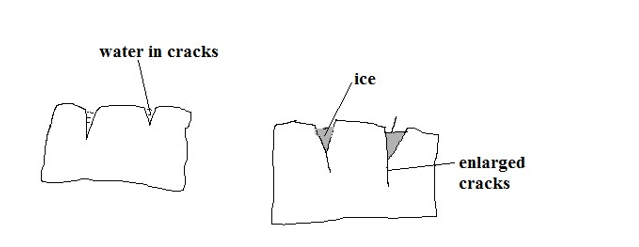
- Breaking of rocks into angular blocks due to repeated freezing and thawing.
- Common in temperate regions or mountainous regions of tropics where temperature fall below zero.
- Water from melting ice collects into small cracks of rocks. o It freezes and expands and exerts pressure on cracks widening them. o Repeated freezing and thawing causes the rocks to break into angular blocks e.g. on Mt. Kenya, Kilimanjaro and Ruwenzori.
Crystal Growth – Break up of rocks due to crystal growth.
It occurs in arid areas.
- High rate of evaporation draws out moisture and dissolved minerals from the rock interior through capillary action.
- The moisture evaporates when it gets to the surface of the rock leaving behind crystals in the cracks and pores of rocks.
- The crystals continue to grow exerting pressure on the cracks or pores widening them and eventually causing the rock to break down e.g. at Hells Gate near Naivasha.
Slaking/Rain Water Action – Breaking up of sedimentary rocks due to alternate wetting and drying.
- When it rains, the rock absorbs water and swells.
- When dry season comes, the rock loses water and the outer surface shrinks.
- The process is repeated and the minerals become loosely attached to another e.g. in Kenyan Coast at Tudor and Miritini areas.
Chemical Weathering
- Weathering involving changes in the chemical composition of minerals making up rocks
Processes
1. Solution
- Break up of rocks as a result of dissolving of minerals in water without chemical change in them. o Rain water falls on rocks with soluble minerals. o The minerals are dissolved and carried down in solution. o The rock gets weakened and crumbles.
2. Carbonation
- Weathering caused by reaction of calcium carbonate in rocks with rain water containing a weak carbonic acid.
- Common in temperate regions.
- Rain water absorbs small quantities of carbon dioxide forming a weak carbonic acid.
H2O+CO2àH2CO3
- The weak carbonic acid falls on limestone rocks reacting with calcite forming calcium bicarbonate.
CACO3+H2CO3àCA (HCO3)
- Calcium bicarbonate is removed from the rock in solution.
3. Hydrolysis
- Weathering caused by reaction of hydrogen ions of water and ions of rock minerals.
- Igneous rocks are greatly affected.
4. Oxidation
- Weathering in which minerals in rocks combine with oxygen in the presence of moisture to form new minerals.
- Rocks containing iron are affected.
- Ferric oxide is formed on the rock surface which appears as a soft brown or red earth which can be scooped by hands.
5. Hydration
- Weathering in which hygroscopic minerals in rocks take up water causing them to swell and expand causing disintegration of rock due to internal stress.
Biological Weathering –
Weathering of rocks due to action of living organisms on them.
Action of plants Mechanical
- The roots grow bigger into the cracks and joints of rocks widening them. o With time the rock separate into blocks (wedging mechanism). o The widened joints and cracks also provide passages for moisture and air to penetrate deeper into cracks facilitating hydrolysis and solution to act at deeper levels.
- Burrowing animals dig and break up small bits of rock from the main rock mass and bring them to the surface.
- By digging they also provide passages for other elements like gases and moisture to reach rocks that are deep.
- Large herds of animals such as cattle, zebra etc. pound the rocks with their hooves as they move resulting in resulting in mechanical breakdown of rocks.
- People break up rocks by using explosives in mining by exploding bombs on the ground and during building of houses and construction of roads.
Chemical
- Plants rot on rock in the presence of moisture and produce organic acid
- It reacts with some minerals within the rock causing decay.
- Animals excrete on rocks and release chemical substances which react with some minerals in rocks causing them to break up.
- Chemical substances released from the industries to rivers cause the water to act on rocks over which it flows.
- Gases such as CO2 emitted from motor vehicles and industries are
- Absorbed by rain and acids such as carbonic or sulphurous which react with minerals causing rock to decay.
Significance of Weathering
Positive
- Leads to soil formation which is important for agriculture.
- Produces other natural resources such as clay used in pottery, brick making, etc.
- Weathered rocks form beautiful scenery for tourist attraction e.g. Hells Gate and crying stones of Kakamega.
- Weakens rocks easing their exploitation by quarrying and mining
Negative
1) May weaken the earths crust resulting in unstable foundations of buildings and roads and eventually lead to their collapse.
MASS WASTING
- Movement of weathered material down slope under the influence of gravity
Factors Influencing Mass Wasting
1. Degree of slope
- Movement of weathered material is faster on steep slopes than on gentle slopes due to the influence of gravity.
2. Climate
- Weathered material in areas receiving heavy rainfall move faster since wet materials have less cohesion.
3. Nature of the material
- Material saturated with water is more likely to move down slope as its heavy.
- Mass wasting is more likely to occur in areas where the weathered material is deep.
- Weathering is more likely where massive rocks lie on weak rocks such as clays, shale than where fine materials lie over weak rocks.
Vegetation
- Surfaces with vegetation experience less mass wasting because it binds weathered material together.
Tectonic movements
- Earth movements such as earthquakes, volcanic eruptions or faulting cause large and widespread mass wasting.
Human activities
- Explosives used in mining and quarrying shake the ground initiating downward movement of materials.
- Mining and quarrying also interferes with the stability of the surface by loosening it making it easy for the loosened materials to move down slope.
Types of Mass Wasting
1. Slow Mass Wasting
- Slow but steady movement of soil or loose rock debris down slope.
Processes
Soil Creep
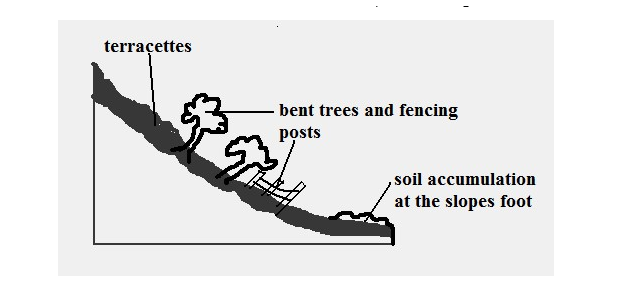
- Slow and steady movement of soil and other fine materials along a very gentle slope.
Causes
- Alternate heating and cooling causing expansion and contraction of particles causing them to change their positions.
- Alternate wetting and drying of soil whereby when it‟s wet its compact and when dry the particles are loosened and tend to move away from each other.
- Trampling and burrowing of animals.
- External forces e.g. shaking by earthquakes, explosives, heavy vehicles, etc.
- Ploughing down hill
- Freezing of soil water causing it to expand which lifts particles at right angles to the slope in a process called heaving.
2. Solifluction
- Movement of saturated soil, gravel and weathered rock down a moderate slope.
- Common in mountainous and very cold climates o Thawing occurs during spring causing top soil to become saturated. o Saturated soil begins to creep over the subsoil which still remains frozen(permafrost).

- Slow and gentle movement of the mass of broken rock particles which accumulate at the base of cliffs (scree) down hill.
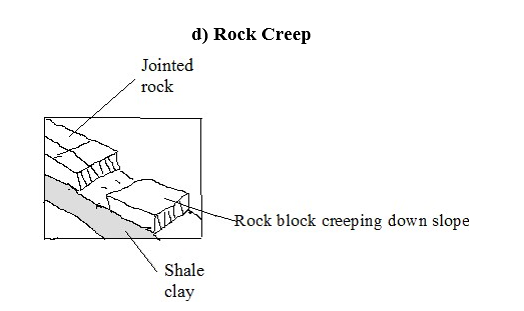
- Slow movement of individual rocks which lie on clay at a very low speed down slope in the presence of moisture.
- Rapid Mass Wasting
- Type of mass wasting involving large amounts of weathered material moving suddenly and fast down slope.
Mud Flow
- Movement of oversaturated weathered material inform of liquid down slope.
- It occurs mainly in dry areas after heavy rains.
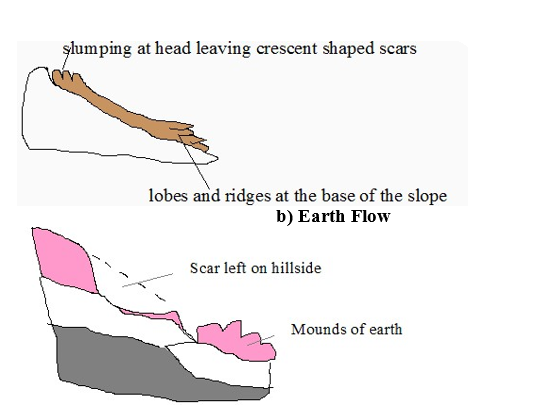
- Movement of saturated earth material on hill sides down slope.
Land Slide
- Sudden slipping of large quantities of loosened surface rock or soil down a slope.
Slump
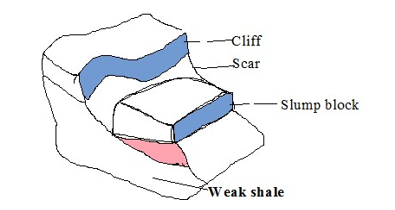
Erosion occurs on the weak rocks at the base of a cliff undercutting the weak rock.
The overlying rocks break off causing the overlying rocks to slide down hill rotating around a curved plane.
Debris Slide
- Sudden downhill movement of accumulated rock debris and other loose material downhill as a whole
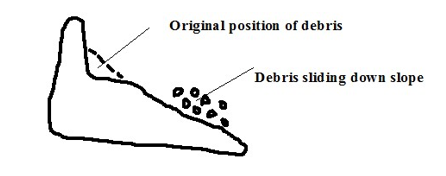
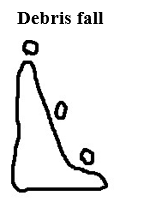
- Sudden free fall of debris from a vertical or hanging cliff to the base of the slope.
Rock Slide
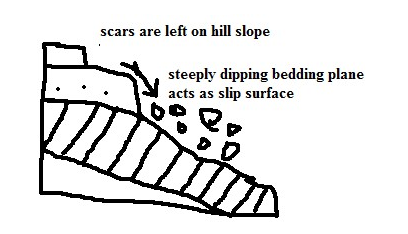
- Sliding down of masses of rock a steep slope along a bending plane, joint of fault.
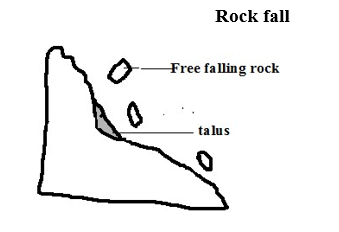
- Falling or rolling of individual rocks or boulders down a steep slope or a cliff.
- Most rapid of all mass wasting.
Avalanche
- Sudden slipping and falling of a large mass of snow, ice and loose rock materials down a mountain side.
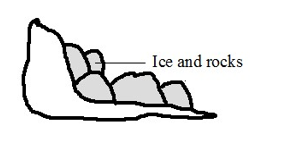
Rain Wash
- Type of mass wasting involving removal of weathered materials by rain water.
- When rains come, the first drops scatter soil particles that have been loosened by drying.
- The increasing downpour then washes large quantities of loosened soil down hill.
Types
Sheet wash – Uniform removal of soil from a large area.
- Rainfall with uniform drops fall on loosened soil on a land with uniform slope. o The water from the rainfall then flows down slope.
- As it does so, it uniformly sweeps all the loose soil from the surface. Its common around L. Baringo and Marigat.
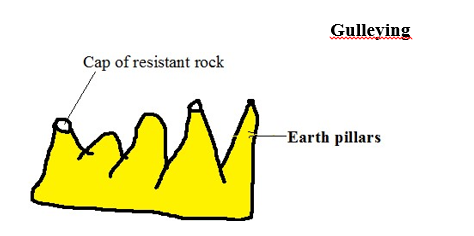
Removal of soil through wide and deep channels called gullies.
- Rain falls on an even slope
- The water irregularly runs down slope along specific channels called rills.
- The channels are widened and deepened by the water to form gullies.
- Neighbouring gullies are widened and the ridges between them are reduced to form earth pillars.
Splash erosion
Removal of soil by rain drops scattering loose particles and carrying them down slope by runoff.
Effects of Mass Wasting On Physical and Human Environment Positive
- Make the soil to become fertile where soil from fertile areas is deposited.
- Leads to formation of new land forms such as scars, depressions, lakes, rock pillars, etc.
Negative
- Soil creep may destroy walls built across the slope when creeping soil exerts pressure on them.
- Decrease soil fertility where fertile soil moves down slope.
- Makes the ground prone to soil erosion especially where scars have formed.
- Hinders transport and communication by blocking railway lines making maintenance to be costly.
- Hinders mechanisation of agriculture e.g. gulleying does not allow movement of vehicles and machinery on farms.
- Leads to destruction of property and loss of live by burying people in their housesandstones falling on escarpments along roads causing accidents.
- May Cause Rivers to change their courses e.g. mud flow.
